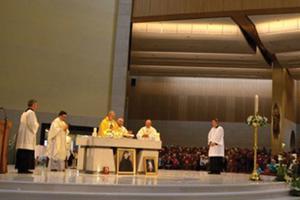Poor Clare’s Painting Blossoms Within Contemplative Life
St. Clare Feast Day Feature: Adoration Anchors Artistry

In an upper chapel in Cleveland’s Conversion of St. Paul Shrine, Sister Mary Thomas dons a smock to protect her habit. Then the 82-year-old religious kneels, picks up a paintbrush and sets to work on a 30-by-16-foot mural she calls Our Lady of the Blessed Sacrament and the Communion of Saints.
For several hours, Sister Mary labors in the shadow of an altar displaying a statue of St. Clare, whose feast day is Aug. 11. Sister Mary’s massive canvas is nailed to the floor to hold it in place and to prevent shrinking.
“I like art to express the great things about our faith,” the Poor Clare said.
God-Given Talent
When Sister Mary entered the convent in 1959, she left behind a promising art career.
“I thought I was giving it up for good,” she said. “I didn’t think I would be doing artwork again.”
Ironically, Sister Mary discerned her religious vocation while painting and studying art history in Rome. A native of Appleton, Wis., she already had graduated from the Art Institute of Chicago and then attended the Instituto Allende in Guanajuato, Mexico. She worked with celebrated muralist David Alfaro Siqueiros, whose style influences her work. She later supported herself as a commercial artist in Chicago and New York City.
The future nun felt no call to religious life when she headed to Italy. While she explored Rome and visited ancient ruins, however, she started to question her future.
Uncertain of God’s will for her, the artist made a 30-day novena to the Virgin Mary that Lent. “My desires changed,” Sister Mary said. “It was a gradual change as the 30 days went by, sort of an evolution.” She slowly detached from her career ambitions.
While attending the Easter vigil in the crypt of St. Peter’s Basilica, she suddenly felt unworthy to receive the Eucharist and left the Communion line. Moments later, an interior “force” urged her to rejoin worshippers waiting for the Blessed Sacrament.
Sister Mary now says she experienced an indescribable joy the instant she received Communion. “I felt the Lord’s presence,” the nun recalled. “He just overtook my life. It was as though my whole life’s work was shown to me then.”
She resolved to devote her life to the Eucharist. When an American priest lent her a directory of religious communities in the United States, she discovered the Franciscan Nuns of the Blessed Sacrament, the former name of the Poor Clares of Perpetual Adoration (whose most famous nun is Mother Angelica of EWTN fame). The artist entered the order’s monastery near downtown Cleveland in November 1959.
Sister Mary did not miss her art during the 14 years that followed. She embraced contemplative life, its ascetic lifestyle and her duties within the cloister.
Then, one year, her community celebrated their superior’s feast day with a display of their individual arts and crafts. For the occasion, Sister Mary sketched a stained-glass window depicting the Holy Trinity. Afterwards, her superior asked her to prepare a portfolio. Ever since then, she helps support the monastery by executing commissioned works and with paintings auctioned at an annual fundraiser (learn more at ThePoorClares.com/sister-mary-thomas-art.html).
Sister’s style reflects her admiration for El Greco and the Mexican muralists. She favors vibrant colors and elongated figures. With titles like The Primacy of Christ and The Baptism of St. Augustine by St. Ambrose, her paintings are rooted in faith. “God is so loving,” she said. “My whole purpose is to let people know his love.”
Even when she depicts sad events, such as Christ’s loneliness in the Garden of Gethsemane, she evokes a sense of victory. In her painting of St. Sebastian, commissioned by St. Sebastian Church in Akron, Ohio, she shows Sebastian’s body riddled with arrows, but he slumps back into the welcoming arms of Jesus. Father John Valencheck, the parish’s pastor, pointed out the skillfully overlapped images. The post to which St. Sebastian is tied melds with the cross of Christ. “There are incredible amounts of catechesis worked into her art,” he said. “Here is a unique voice: a woman of faith reaching people through the medium of paint.”
Her enthusiasm for Our Lady of the Blessed Sacrament and the Communion of Saints never wanes. An African-American parish in Philadelphia commissioned Sister Mary’s current project several years ago, with the request that she portray Jesus and Mary with black skin. That parish later closed, but Sister Mary persevered with the work. (Another interested buyer has since appeared.) Sister Mary presents the adult Jesus in his mother’s arms to emphasize Mary’s role in the Incarnation. Christ holds up the chalice and Host. St. Peter Claver and other recognizable saints cluster around Jesus and Mary. Holy men and women across the ages join them. After Pope Francis’ election, Sister Mary added him to the mural.
Art and Contemplation
While the Poor Clare’s art career flourished, she continued to participate in her community’s daily life. She served as the monastery’s treasurer, and from 2010 to 2013, as its superior.
She credits contemplative life for nurturing her art: “You can’t have the painting without the spiritual life.”
Sister Mary prays before the Blessed Sacrament from 4 to 6am and again from 8 to 9am every day. “More than anything right now, I pray for expectant mothers,” she said. “I pray for an end to abortion. I pray for all the pro-life movements.”
Although Sister Mary’s art gives her joy, it is not what she cherishes most about her 56 years at the monastery. “I really treasure perpetual adoration the most. No matter what time of day, we can encounter Christ himself, his body and blood, soul and divinity.”
Jerri Donohue writes from Brecksville, Ohio. Jerri Donohue photo of Sister Mary.
- Keywords:
- Aug. 9-22, 2015

















